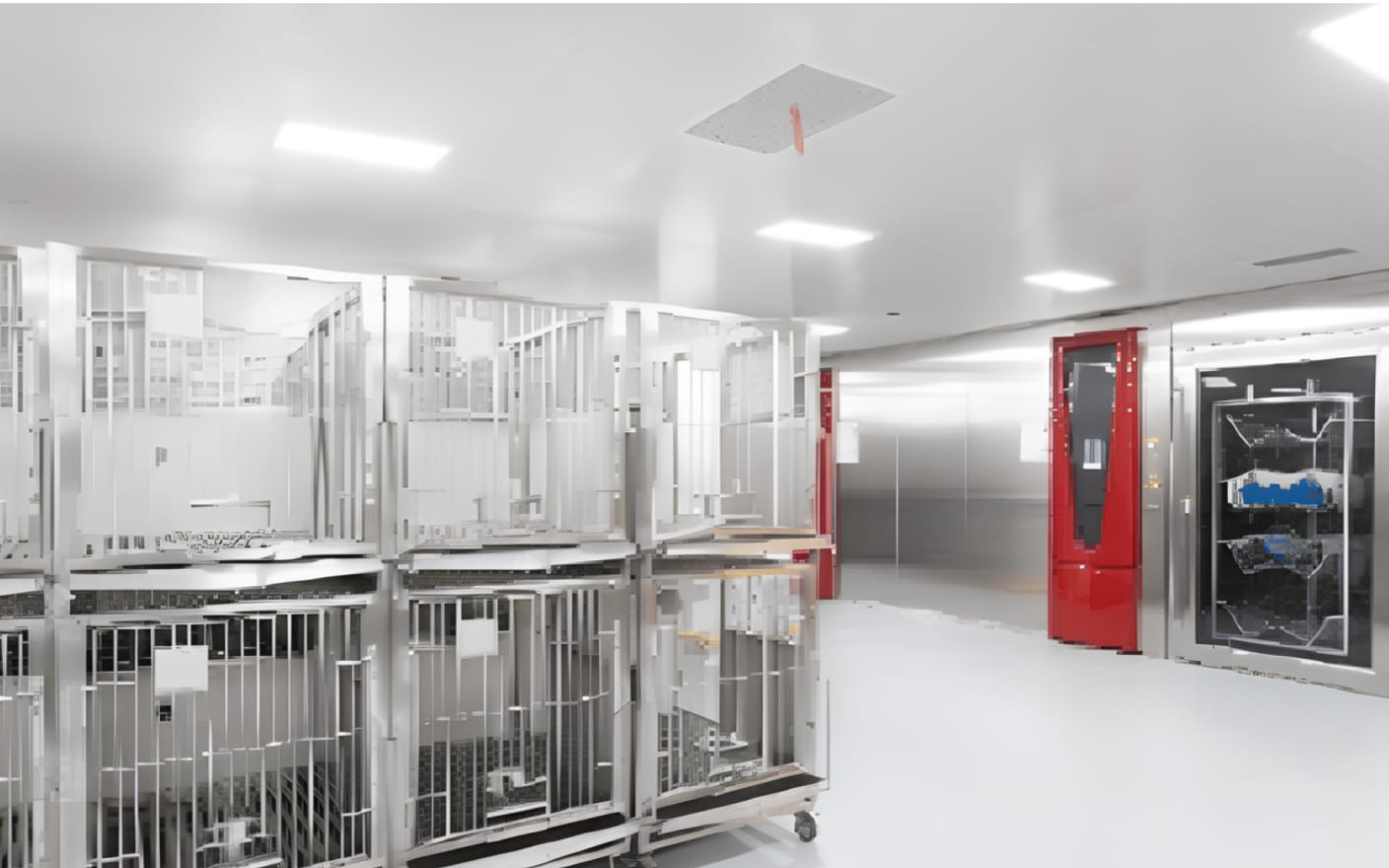Preclinical pharmacokinetic (PK) studies of ophthalmic drugs play a significant role in enhancing our understanding of the processes of absorption, distribution, metabolism, and excretion of drugs in the eye. These studies also provide insights into the concentration changes and steady-state distribution within ocular tissues, as well as facilitate the evaluation of potential interactions between ophthalmic drugs. This knowledge is of utmost essential for determining appropriate dosage regimens, doses, and administration frequencies to ensure optimal drug concentrations and desired duration of action in target ocular tissues.
Through the assessment of PK properties specific to ocular drugs, it is possible to contribute to the screening and optimization of candidate drugs, thereby enhancing their efficacy and safety profiles. Moreover, they provide valuable support in the design and interpretation of clinical trials.
Ophthalmic in vivo PK studies need to consider specific characteristics like small eye volume and precise tissue structure. Therefore, a high level of technical expertise is required to ensure accurate drug administration, sample collection, and tissue isolation to ensure accurate drug delivery and obtain precise samples.
Physiological barriers exist in the eye, which limit drug absorption and distribution. Therefore, the role of these barriers needs to be considered in the selection of administration routes and drug delivery systems. Additionally, ophthalmic examinations are essential both before and after experiments to assess the condition and health of the eyes of pre- and post-dosing, establish baseline measurements, and monitor any effects or adverse effects that may occur. Since different animal species have variations in eye anatomy and physiology, it’s essential to select the right animal models to ensure reliable and comparable experimental results. Furthermore, the choice and design of ophthalmic drug formulations can also affect how well the drug is absorbed by the body. This article provides a detailed exploration and application of research methods in preclinical pharmacokinetic studies of ophthalmic drugs focusing on ophthalmic administration, sample collection and processing, ophthalmic examinations, and the formulation of ophthalmic drugs in preclinical studies. We aim to provide valuable insights into the exploration and application of different methods used.
Ocular administration routes and their advantages and disadvantages
The eyeball can be anatomically divided into two segments: the anterior segment and the posterior segment. The anterior segment, which accounts for approximately one-third of the eyeball, consists of the cornea, conjunctiva, iris, ciliary body, lens, and aqueous humor. The posterior segment, accounting for approximately two-thirds of the eyeball, includes the sclera, choroid, retina, and vitreous body 1. Precisely identifying the location of the anterior and posterior segments in ocular drug administration helps facilitate drug diffusion to specific target locations for therapeutic effects. Generally, topical administration on the ocular surface, including intracameral injection, is commonly used for the anterior segment, while intraocular or periocular administration routes are often employed for the posterior segment.
Existing methods of ocular drug administration primarily involve topical administration through eye drops and ointments/gels, as well as subconjunctival injections, intracameral injections, intravitreal injections, and retrobulbar injections. Sedation or anesthesia is generally required for these injection methods, except for eye drops and ointments/gels. It is important to exercise caution during injections into the eyeball to avoid blood vessels, the posterior capsule of the lens, and the retina. Each administration method has its own advantages and disadvantages, which are outlined in Table 1. Figure 1 illustrates various injection routes for ocular drug administration.
|
Drug delivery |
Advantages |
Disadvantages |
|
Topical administration |
Non-invasive and high patient compliance |
Frequent drug administration, non-target tissue drug exposure, and significant drug loss |
|
Intracameral injection |
Reduced systemic and corneal adverse effects, and high drug concentration in the anterior chamber |
Invasive, unable to achieve effective drug concentration in the ocular posterior segment |
|
Intravitreal injection |
Low frequency of administration, long-lasting effect, topical pharmacology, and high bioavailability |
Invasive, superior ocular complications, and retinal toxicity |
|
Periocular injection |
No change in intraocular pressure, high dosage, and long duration of drug action |
Invasive, frequent administration, and risk of retrobulbar hemorrhage |
|
Subtenon injection |
Relatively less invasive, fewer complications, and maintenance of high drug concentrations |
Risk of conjunctival edema or subconjunctival hemorrhage and need to cross the retinal pigment epithelial barrier |
Table 1. Different ocular drug delivery and their advantages and disadvantages 2

Figure 1. Multiple injection routes of drug administration in the eye
Ocular tissue collection and sample processing
Ocular tissues that can be collected by anatomical separation include the lacrimal gland, conjunctiva, eyelids, cornea, iris, ciliary body, lens, retina, choroid, sclera, and optic nerve. The aqueous humor and vitreous humor can be achieved by puncture sampling techniques. Additionally, the tear can be collected by capillary or filter paper strip method. The types of ocular biological samples that can be collected from different animal species are shown in Table 2.
|
Type of sample |
Conjun-ctiva |
Cornea |
Iris |
Retina |
Choroid |
Sclera |
Crystalline lens |
Ciliary body |
Vitreous humor |
Lacrimal gland |
Lower eyelid |
Optic nerve |
Aqueous humor |
Tears |
|
Mouse |
√ |
√ |
√ |
√ |
√ |
√ |
√ |
√ |
√ |
√ |
√ |
√ |
√ |
√ |
|
Rat |
√ |
√ |
√ |
√ |
√ |
√ |
√ |
√ |
√ |
√ |
√ |
√ |
√ |
√ |
|
Rabbit |
√ |
√ |
√ |
√ |
√ |
√ |
√ |
√ |
√ |
√ |
√ |
√ |
√ |
√ |
|
Dog |
√ |
√ |
√ |
√ |
√ |
√ |
√ |
√ |
√ |
√ |
√ |
√ |
√ |
√ |
|
Monkey |
√ |
√ |
√ |
√ |
√ |
√ |
√ |
√ |
√ |
√ |
√ |
√ |
√ |
√ |
Table 2. Types of ocular biological samples that can be collected from different animal species
Ophthalmic sample processing
Ocular tissues vary in size, structure, and characteristics, necessitating different processing methods. Different types of equipment, such as high-shear homogenizers, ball mills, and multifunctional biological sample homogenizers, may be employed for processing the tissue samples.
High-shear homogenizers (Figure 2, left) operate on the principle of electric motor-driven blades that shear tissues into fine particles. They have the advantage of high rotational power, making them suitable for homogenizing voluminous tissues like the lacrimal gland and lens. However, a drawback of using these devices is that the samples need to be processed individually, posing risks of cross-contamination during sample handling.
The ball mill (Figure 2) utilizes the collision and friction of grinding beads to pulverize samples. Their advantages include no cross-contamination between samples, the ability to process multiple samples simultaneously, and high homogenization efficiency, making them suitable for processing smaller and fragile tissue samples such as the iris, ciliary body, retina, choroid, and optic nerve. However, it is less effective for tougher tissues like the cornea, sclera, and conjunctiva.
The multi-functional biological sample homogenizer (referred to as a homogenizer, Figure 2) possesses three-dimensional high-speed vibration capabilities, enhancing its homogenization efficiency and providing enhanced homogenization capabilities of tissues such as the cornea, sclera, and conjunctiva. Moreover, with the assistance of the BR-Cryo cooling system, it can maintain low sample homogenization temperatures.

Figure 2. Ophthalmic sample processing apparatuses
Figure 3 displays a comparison of the homogenization effects of the high-shear homogenizer and the homogenizer on corneal tissues. The images reveal that the tissue fragments produced by the homogenizer are smaller, more dispersed, and exhibit better homogenization than those homogenized with the high-shear homogenizer.

Figure 3. Comparison of the homogenizing effects of a high-shear homogenizer and a homogenizer (200×)
A: The cornea was homogenized for 2 min at 30,000 rpm using a high-shear homogenizer. B: The cornea was homogenized for 2 min at 6 m/s using a biological sample homogenizer.
Ophthalmic examination
Following ocular drug delivery, in addition to collecting samples for analysis, close observation of ocular abnormalities is essential. Experienced veterinarians should conduct detailed examinations and evaluations using ophthalmic equipment.
The non-rodent (large animal) PK Team of WuXi AppTec DMPK masters extensive experience in ocular drug delivery, an experienced veterinary team, and comprehensive ophthalmic examination equipment (Figure 4). The team also has established comprehensive ocular scoring criteria (Draize eye irritation score and McDonald–Shadduck scoring system) for ophthalmic examinations.

Figure 4. Ophthalmic instruments
Ophthalmologic examination items
-
Intraocular pressure testing is commonly performed using a tonometer.
-
During pupillary reflex examination, the pupillary reflex of conscious animals without pupil dilation is examined under normal or dim lighting conditions.
-
Under dim lighting conditions, the eyes were observed using binocular indirect ophthalmoscopy combined with appropriate refractive lenses to assess the overall eye condition and eye structure. In some cases, a direct ophthalmoscope can be used for further examination of retinal lesions. Slit lamps can be used to further examine the transparent tissues of the eye, such as the cornea, anterior chamber, lens, and vitreous humor, to determine the location, nature, size, and depth of the lesions.
-
Unconventional ophthalmic examinations include sodium fluorescein staining.
-
Fundus imaging visually represents the condition of the fundus and can also monitor changes in the fundus.
-
Ophthalmic microscopy is used to assist drug administration and confirm the tissue integrity of the ocular posterior segment before and after drug administration.
Examples of ophthalmic examinations are shown in Figure 5.

Figure 5. Examples of ophthalmic examinations
Ocular scoring
Draize ocular irritation score
The drug that is likely to cause irritation to the eyes can be assessed using the Draize ocular irritation score. The scoring system is based on a comprehensive assessment of corneal opacity, including the area of opacity, the iris condition, conjunctival congestion and swelling, and secretion levels, to determine the ocular irritation score of the tested animals 3.
McDonald–Shadduck scoring system
This scoring system is used to determine the condition of ocular tissues by evaluating parameters, such as conjunctival congestion, conjunctival edema, conjunctival secretions, aqueous flashes, iris involvement, corneal clouding, corneal neovascularization, fluorescein staining results, and the lens condition 4.
Preclinical ophthalmic formulations
In order to enhance the bioavailability and safety of ophthalmic drugs, different routes of administration have different requirements for ophthalmic formulations. Topical formulations for ocular surface administration need to achieve high corneal residence time and enhance drug penetration. On the other hand, ophthalmic injection formulations need to consider factors such as isotonicity and sterility.
When designing topic formulations for ocular surface administration, one key consideration is to increase the drug’s residence time on the ocular surface to ensure optimal efficacy. Another important factor is to enhance the drug’s permeability, allowing it to penetrate the cornea and enter the ocular tissues. To address these factors, DMPK has established an in vitro permeation testing platform known as In Vitro Permeation Testing (IVPT). Through the IVPT platform, the permeability of drugs in the cornea can be improved by optimizing the formulation.
In the design of ophthalmic injection formulations, isotonicity is crucial to ensure that the formulation does not adversely affect ocular tissues/cells during intraocular administration. Additionally, sterility is an essential factor in ophthalmic and minimizes the risk of infection.
Ocular topical delivery formulations
Ocular topical delivery formulations are a category of formulations that meet patient needs, are non-invasive, and have a fast onset of action. Common formulations for ocular topical drug delivery comprise solutions, suspensions, emulsions, and gels.
Solutions
Solutions are common formulations via eye drops, providing immediate effects. Drugs administered through eye drops could be rapidly absorbed into the corneal and conjunctival tissues, thus increasing the drug concentration at the target site. To optimize solution formulations, the following strategies are often employed in ophthalmic formulation development:
-
Cyclodextrin complexation to improve the solubility of poorly water-soluble compounds;
-
Increasing the viscosity of eye drop solutions to prolong the residence time of the drug in the cornea;
-
Using penetration-enhancing reagents to enhance drug permeability
Suspensions
Suspensions are homogeneously dispersed formulations containing insoluble drug particles and typically including dispersants and solubilizers. The size of the drug particles determines the time required for drug molecule absorption by corneal tissue, which ultimately affects the proportion of drug clearance by tears. Methods for preparing particle size in suspensions include ball milling and ultrasonication.
Emulsions
An emulsion is a homogeneous preparation consisting of an aqueous phase (denoted by W), an oil phase (denoted by O), and an emulsifier. The advantages of emulsions include improving lipophilic drug solubility, facilitating corneal penetration, and prolonging the residence time of the preparation in the anterior chamber of the cornea.
Ophthalmic injectable formulations
Injectables are commonly used for posterior segment ocular drug delivery, such as for intravitreal administration. Both traditional small molecule compounds and novel biologics can be delivered to the target tissues by injection. The quality of the formulation is one of the key factors influencing ophthalmic injectable drug administration. Common quality parameters include:
(1) pH: the eye’s tolerance range is pH 6–8;
(2) Osmolality: isotonic
(3) Aqueous solution: sterile and free from bacteriostatic and antioxidants.
With the rapid development of scientific technology and material science, there are many ophthalmic formulation vehicles available (Table 3). Many novel drug delivery technologies have been developed, such as the cutting-edge Punctum Pug Delivery Systems (PPDS).
|
Types |
Representative agents |
|
pH adjuster |
Phosphate buffer and borate buffer |
|
Osmotic stress regulator |
Sodium chloride, boric acid, and glucose |
|
Antibacterial agent |
Organic mercury (thiomersal and mercury nitrate), quaternary ammonium salts (benzalkonium chloride and benzalkonium bromide), alcohols (tert-butyl trichloride), esters (hydroxyphenyl methyl ester), and amidines (chlorhexidine) |
|
Viscosity modifier |
Poloxamer, polyvinyl alcohol, polyvinyl ketone, hyaluronic acid, sodium carboxymethyl cellulose, and carbomer |
|
Solubilizer |
Surfactant (Tween) |
|
Antioxidant |
Sodium bisulfite and sodium sulfite |
|
Penetration enhancer |
Calcium ion chelator (sodium ethylenediaminetetraacetic acid), surfactants (cholate), bacteriostatic agents (benzalkonium chloride), saponin, and cyclodextrins (hydroxypropyl-α-cyclodextrin, hydroxypropyl-β-cyclodextrin) |
Table 3. Common excipients used in ophthalmic solutions
Conclusion
The in vivo PK team of WuXi AppTec DMPK has extensive experience in ocular drug delivery, sample collection and processing, examinations, and ophthalmic formulation development. The team is capable of conducting ophthalmic PK assays in different species, such as mice, rats, rabbits, dogs, monkeys, and pigs. The team is equipped with various high-precision equipment and instruments, which can produce efficient and high-quality study results. In addition, the team can provide technical support and customized services according to the client’s needs, facilitating research on ophthalmic drug development.
If you want to learn more details about the strategies for ophthalmology, please talk to a WuXi AppTec expert today to get the support you need to achieve your drug development goals.
Authors:Chao Zhang, Jie Li, Chen Ning, Zhihai Li, Xuan Dong, Jacob Zhi Chen, Shoutao Liu
Committed to accelerating drug discovery and development, we offer a full range of discovery screening, preclinical development, clinical drug metabolism, and pharmacokinetic (DMPK) platforms and services. With research facilities in the United States (New Jersey) and China (Shanghai, Suzhou, Nanjing, and Nantong), 1,000+ scientists, and over fifteen years of experience in Investigational New Drug (IND) application, our DMPK team at WuXi AppTec are serving 1,500+ global clients, and have successfully supported 1,200+ IND applications.
Reference
[1] Koppa Raghu P, Bansal K K, Thakor P, et al. Evolution of nanotechnology in delivering drugs to eyes, skin and wounds via topical route[J]. Pharmaceuticals, 2020, 13(8): 167
[2]宋硕,王若男,钱仪敏,孟永,周璐,李华.眼科药物的药动学研究策略[J].中国新药杂志,2021,30(18):1668-1674.
[3]王庆利,彭健.Draize眼刺激性试验的评价[J].中药新药与临床药理,2005(04):301-304.DOI:10.19378/j.issn.1003-9783.2005.04.026.
[4]GB/T 28538-2012, 眼科光学接触镜和接触镜护理产品 兔眼相容性研究试验[S].
Related Services and Platforms




-

 In Vivo PharmacokineticsLearn More
In Vivo PharmacokineticsLearn More -

 Therapeutic Areas DMPK Enabling PlatformsLearn More
Therapeutic Areas DMPK Enabling PlatformsLearn More -

 Rodent PK StudyLearn More
Rodent PK StudyLearn More -

 Large Animal (Non-Rodent) PK StudyLearn More
Large Animal (Non-Rodent) PK StudyLearn More -

 Clinicopathological Testing Services for Laboratory AnimalsLearn More
Clinicopathological Testing Services for Laboratory AnimalsLearn More -

 High-Standard Animal Facilities and Animal WelfareLearn More
High-Standard Animal Facilities and Animal WelfareLearn More -

 Preclinical Formulation ScreeningLearn More
Preclinical Formulation ScreeningLearn More -

 Ophthalmic Drugs DMPK ServicesLearn More
Ophthalmic Drugs DMPK ServicesLearn More -

 CNS Drugs DMPK ServicesLearn More
CNS Drugs DMPK ServicesLearn More -

 Respiratory Drugs DMPK ServicesLearn More
Respiratory Drugs DMPK ServicesLearn More -

 Topical and Transdermal Drugs DMPK ServicesLearn More
Topical and Transdermal Drugs DMPK ServicesLearn More
Stay Connected
Keep up with the latest news and insights.















